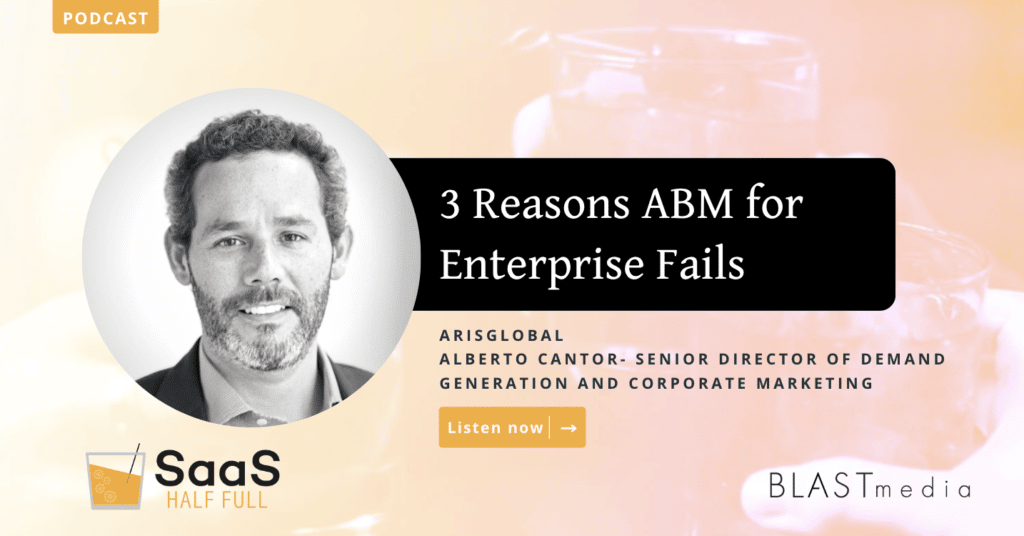If you sell into the enterprise or are thinking of swimming upstream, this is the episode for you.
Alberto Cantor is the Senior Director of Demand Generation and Corporate Marketing at ArisGlobal, and its SaaS product is sold to big-honkin’ pharmaceutical companies. Yes, large, conservative buying teams in a super-regulated industry with long sales cycles. Can account-based marketing (ABM) work in this environment?
Yes, but not if you give up easily. In this episode, Alberto talks about the three pillars he had to master before he got ABM for enterprise right (after two failed attempts) and how to set expectations for ABM performance across the entire organization.
The secret sauce to successful enterprise ABM
Alberto cited three building blocks to success that early ABM adopters should review when preparing to launch their enterprise-level strategy.
1. Integrated infrastructure
Stellar ABM starts with a robust pipeline of generalized marketing initiatives. Alberto mentioned that automation, analytics and an established digital presence — including email marketing efforts and a good website — are all important to cinch before implementing ABM.
Why? Well, it’s right there in Alberto’s title: demand generation and marketing go hand in hand. Generating positive brand awareness and association is critical for ABM, particularly on a larger scale.
“Think about branding and how your brand marketing and brand efforts integrate within [ABM] campaigns. Brand should be — ideally — omnipresent,” said Alberto. And in the virtual age, building omnipresence starts with a tactical digital footprint. Alberto suggests investing in web analytics software and marketing automation tools to build a preliminary tech stack. These technologies allow marketers to hone in on who exactly is viewing and interacting with their content.
2. Internal alignment
ABM may include “marketing” in its acronym, but its most successful iterations require inter-team effort that extends far beyond the marketing department. To properly invest in ABM, sales, marketing, brand and events teams must work in lock-step. Essentially, according to Alberto, if a team’s daily work impacts the health of an account, they’re partially responsible for ABM’s success.
“All fronts need to work together to really try to penetrate and engage that account or the individuals within that account that we’re targeting,” said Alberto. He also clarified that this building block is often the most difficult to nail. But when proper alignment comes to fruition, the dividends are immense.
3. Intentional (and frequent) level-setting
The final element of a killer ABM strategy requires the involvement of high-level executives and stakeholders. Alberto said that marketers deploying ABM must communicate clearly with leaders about the expectations surrounding the strategy. For example, what is the expected timeline associated with ABM? How soon can executives expect to see results, and how will the team communicate those results?
When leaders understand the upfront costs associated with ABM, they’re far more likely to appreciate the brand and demand progression that these strategies ultimately create. That’s a win-win for everyone involved.
It’s only natural that ABM success — particularly enterprise-level ABM — requires several parties to participate. After all, ABM threads a delicate needle to identify key targets among an enormous haystack of accounts and stakeholders. In other words, it’s all hands on deck.
“It’s not just marketing [building ABM], the SDR team doing it, or the sales team doing it. It has to be everyone doing it at the same time at different levels, different tactics, different content, different strategies, but everyone sort of pointing towards the North Star within that account,” Alberto said.
To listen to more of Alberto’s insights, listen to Episode 338 of SaaS Half Full.

